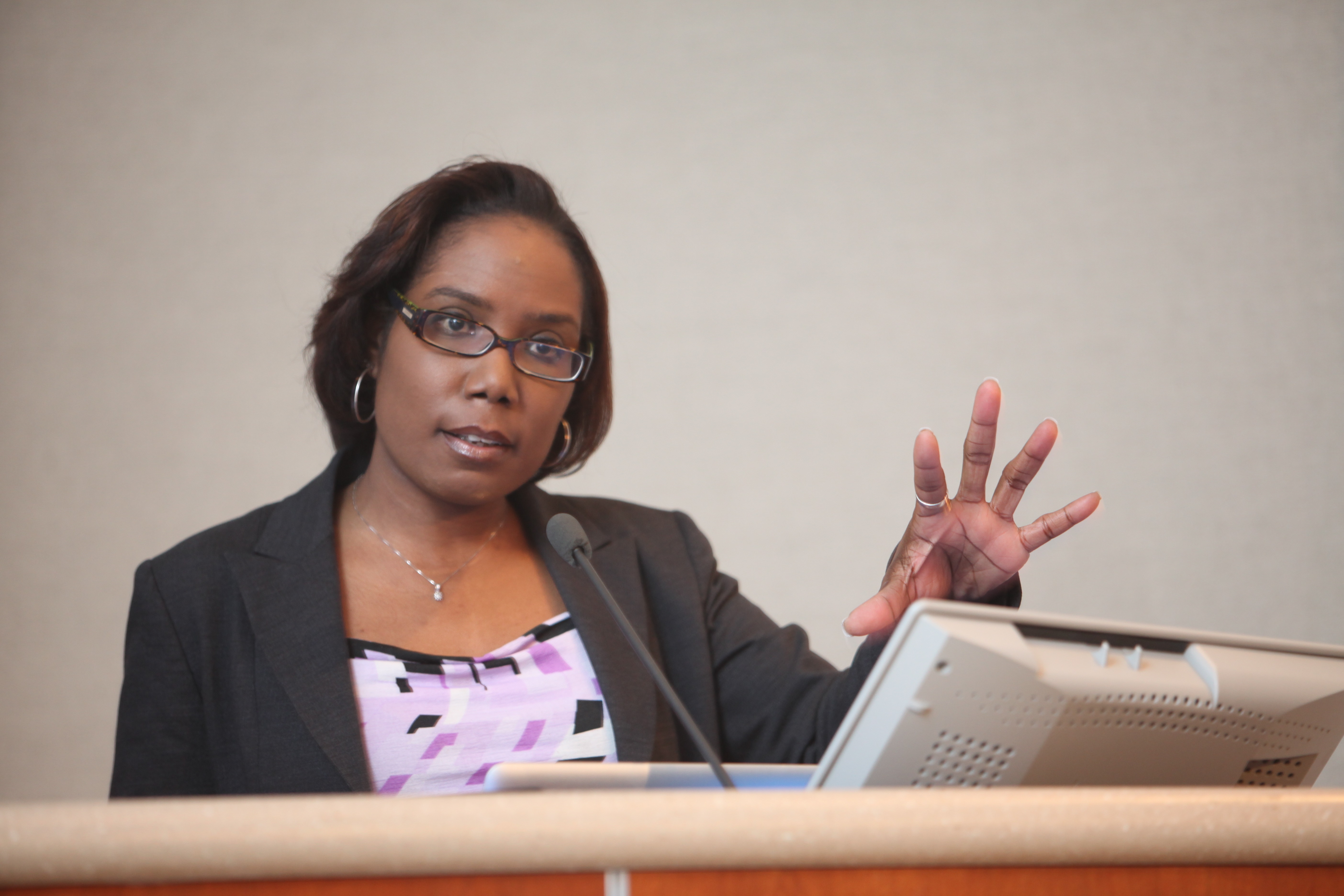UConn School of Medicine’s Dr. Linda Barry attended an invitational meeting in May of national experts hosted by AcademyHealth, in collaboration with the Robert Wood Johnson Foundation’s Optimizing Value in Health Care program, to discuss the barriers to patient centered care in the U.S. Barry is the author of one of the three newly published online viewpoint articles by AcademyHealth that resulted from the meeting entitled: Barriers to Patient Centered Care: My Perspective as a Physician, Patient, Caregiver and Advocate. Here is the published article in full:
It should be an obvious concept. Patient centered care (PCC) should be the focus of health care delivery in the United States. The patient determines when and how to engage with the health care system. The patient’s needs dictate the manner in which specific resources are utilized.
However, the fact is that PCC remains more a concept for many rather than a reality.
Several factors associated with the individual’s circumstances, access, structural inequities of the health care system and social determinants of health create barriers to PCC.
Patient Centered Care: Currently More a Concept than a Reality for Many

Proposed innovative ideas and policies aim to ensure high quality care and improved outcomes while achieving better cost control, if not cost savings. However, the success of such initiatives will be compromised if PCC is not integrated into these efforts. By highlighting some of the barriers to achieving PCC from my perspective, I hope that such initiatives will address them to ensure the best outcomes for patients. My experiences as a physician, a caregiver, a patient, and a patient advocate inform my perspective.
Often the discussion around PCC originates from a viewpoint of privilege. This presumes the patient has the agency to advocate for herself, the luxury of unfettered access to health care resources, generous health insurance coverage, and an insightful understanding of how the health care system actually works. The reality does not align this way and can differ dramatically based on the condition in which you present for care. If you are a gunshot victim or suffer a ruptured appendix, PCC is distilled to the essentials to maintain life.
As a physician, I am focused on doing what is necessary to obtain a good outcome. So, in an acute care setting like this, the patient and caregiver are often unable to participate in the care plan. PCC becomes center stage during the recovery period. For those dealing with chronic conditions such as diabetes or hypertension, the full benefits of PCC can potentially be realized. The long term nature of these diseases affords the opportunity to develop relationships with physicians and medical teams. Decision-making can be a collaborative process. The pendulum swings the other way when patients face the end of life. Sometimes it is abrupt and unforeseen.
At other times, it can be a long drawn out process. The PCC approach is upended by the vagaries of the disease process. When one is diagnosed as terminal with advanced cancer, the end of life is marked by the complications related to the cancer rather than the cancer itself. The complications become acute episodes superimposed on the chronic process of dying that undercut the ability to adhere to the patient’s wishes. Alternatively, the patient may become so debilitated that one’s wishes are not fully known. Often the patient cannot fully engage in the decision-making process. It is often the caregiver, if present, and the insurance company that determines how care is delivered or if at all in the last stages of life.
The Caregiver Role as a Critical Patient Advocate is Undermined
The physicians and other health care providers often do not give the caregiver enough acknowledgement nor value their contribution to the improved care and outcome of the patient.
When my sister, diagnosed with end stage cancer, designated me as her health care proxy, the health care system only viewed my role in legal terms. I was more than that. I sat at her bedside with her doctors to ensure that she understood the medical terms and care plan. When she was too sick to make decisions, the responsibility fell upon me. Being a caregiver is not a part-time job which health care providers only acknowledge when a medico-legal decision must be made. When the ill bedridden patient is discharged to home, the caregiver is responsible for carrying out the medical directives. How is the patient or the caregiver supposed to anticipate the patient’s needs when they are not included in the discussions nor planning? The insurance companies exclude the family in the role as caregivers except when it is an opportunity to cut back on supplies or assistance since they serve as de facto home health aides, despite the lack of training and familiarity with the consequences of the disease process. When you are critically ill, the one person who will advocate for you is often the caregiver.
It is imperative that they are included (with the permission of the patient) in developing the care plan. To exclude the caregiver from PCC is to undermine the ability to execute the medical directives aimed at improving the health of the patient.
How Insurance Status Undercuts Patient Centered Care
Let’s talk about the agency of patients, which is an integral part of PCC. Do we as patients truly have the agency to independently and freely make choices regarding our medical care? I would submit that a generous insurance policy would give that illusion. Yet, if you are on a bare bones medical plan with a high deductible and co-pay, on Medicaid, or are uninsured, you know that this is not true. Case in point…I had a family member on Medicaid diagnosed with cancer. She received her care at a prestigious highly regarded hospital. She never had the same senior doctor (attending) involved in her care on any given week. While the senior trainee (fellow) was a constant in her care, a rotating cadre of oncologists served as consultants. I was told she could not see one consistent attending because they do not take her insurance. Every major medical decision had to be vetted by a different attending who never took the time to know her. This is not PCC. The health care system treats patients on Medicaid or the underinsured like second
class citizens. So, despite several doctors practicing in a specific geographic area, their refusal to accept Medicaid due to low reimbursement rates results in a dearth of opportunities for patients to receive care. These patients do not get to pick and choose the best doctor for them when the options are so few and far between. For the uninsured, it is even worse. There is often only one option – the emergency room, when the situation has become dire. PCC needs to address these patient populations so they can be empowered in contributing to the care plan and the decision making process.
Bias, Racism and Social Determinants of Health Must be Addressed
Lastly, we must acknowledge that PCC occurs in an ecosystem based on societal structures marked by bias, racism and the social determinants of health (SDH). These factors contribute to persistent health disparities while impeding the benefits of PCC from being realized. The changing demographics indicate that people of color will become the majority in the near future. Yet, their health outcomes and those of other marginalized groups remain compromised due to bias and racism. PCC will never succeed if these issues remain unaddressed. While unconscious bias and cultural competency trainings are heartfelt attempts to do so, where is the evidence of their positive, sustained impact? Do health care providers recognize in real time their biases affecting care and adjust accordingly? Often it is the patient who is compelled to point it out, which undermines the ability to establish the foundational trust necessary for PCC. Health care delivery, more so in the outpatient setting compared to inpatient, does not allow for full assessment and provide the capacity to address the SDH at the point of contact. PCC would factor how the SDH of poverty would prevent the patient from buying insulin if one is uninsured with the rent due.
Racism uniquely stands alone as an independent factor that adversely impacts health outcomes, often despite socioeconomic status, education and good insurance coverage. The stark reality of black women being four times more likely to die in childbirth than their white counterparts is illustrative of this fact.1 Their concerns are often minimized or dismissed. Becoming a mother should not be a death sentence consigning a child to be motherless.
The inability to recognize and acknowledge structural racism embedded in how health care is delivered will perpetuate health disparities. PCC is incompatible with racism. Diversifying the
health care workforce is just a first step. The policymakers and Csuite of health care centers need to reflect the demographics of the communities they serve. This will translate into a more insightful, comprehensive approach to PCC. It will move the needle toward eliminating health disparities.
Patient Centered Care Must Be Dynamic and Responsive
I believe PCC is an achievable goal that must be available to all patients rather than a select few. On a macro level, we must challenge the health care system to evolve and improve via policies that tackle issues such as those I have raised here. On a granular level, PCC must value the individual patient and the circumstances influencing contact with the health care system. PCC must be dynamic and responsive to the patient and all the intersectional characteristics one embodies. This approach will facilitate better patient experience and improve outcomes.
Barry’s viewpoint article was originally published by AcademyHealth on Sept. 23 online here.



